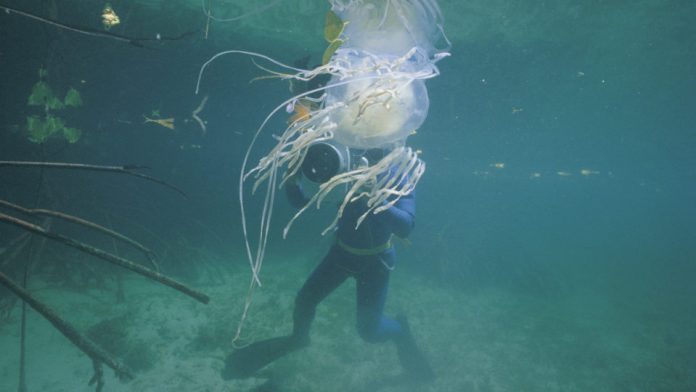Warm Australian waters are home to the box jellyfish (Chironex fleckeri), which is considered to be one of the most venomous animals on the planet.
Box jellyfish stings lead to excruciating pain lasting days, tissue death and scarring at the site of the sting, and with significant exposure, death within minutes. While most jellyfish stings do not lead to death, pain and scarring is quite common.
Despite its potent ability to cause pain and death, to date we’ve had very little understanding of how this deadly venom works. This makes it very difficult to understand how it can cause so much pain – and how to develop medicines to block venom actions.
Published today, our new research has uncovered a potential antidote for box jellyfish venom. By working with humans cells and the gene-editing tool CRISPR, we identified a common, cheap drug that is already on the market and which could be a candidate for treating box jellyfish stings.
Flipping all the switches
This work began in 2012, when we set out to determine what it was about box jellyfish venom molecules that made them so effective in causing pain and damage.
The venom didn’t seem to work through the known pathways that cause cell death. So we used CRISPR genome editing technologies in human cells grown in the laboratory. This let us systematically turn off each gene in the human genome, and test to see which of these is needed for the jellyfish venom to kill the cells.
It’s kind of like flipping all the switches in a house, trying to figure out which one turns off the kitchen lights, but at the whole genome level. We actually didn’t even know if it would be possible to find single genes that when turned off could block the venom action.
But luckily, we were successful. While normal human cells exposed to venom die in the laboratory within five minutes, we identified gene-edited cells that could last for two weeks continually exposed to venom.
Putting the evidence together
Then using new DNA sequencing technologies (that allow us to identify CRISPR guide RNAs targeting specific genes), we identified which human genes had been switched off in our genome editing experiments.
By putting the evidence together, we worked out which genes the box jellyfish venom needs to target in order to kill human cells in the lab.
One we identified is a calcium transporter molecule called ATP2B1, and is present on the surface of cells.
We tested a drug that we know targets this gene. If we added the drug before the venom, we could block cell death, but if we added the drug after the venom, it didn’t have any effect.
So this helped us understand more about how the venom works – and maybe even how it causes pain. We are still looking at this particular pathway in more detail, but at the moment it doesn’t seem promising for a therapy.
Stopping cell death
Next we looked at the pathways involved in how box jellyfish venom kills cells.
We found four of the top ten genes required for venom action were all part of a pathway that makes cholesterol in cells.
Since cholesterol has been heavily studied over the last 30 years, there are already drugs available that target lots of different steps in cholesterol regulation. We focused on drugs that could bind to cholesterol and remove it quickly, basically acting like a cholesterol sponge.
We found these drugs could completely block the box jelly fish venom’s ability to kill human cells in the lab if added before venom exposure. We also found there is a 15-minute window after venom exposure where if we add this cholesterol sponge, it still blocks venom action.
This was exciting, as the capacity to have effect after the venom means the drug could work as a treatment in the case of being stung by a box jellyfish.
So far our additional studies show that these same drugs can block pain, tissue death and scarring associated with a mouse model of box jellyfish stings.
Moving towards a human treatment
The really cool thing about this work is that the potential box jellyfish antidote we found is in a family of drugs called cyclodextrins. These are known to be safe for us in humans, and are cheap and stable.
So now we are trying to work with the state or national government, or first responders, to see if we can move this venom antidote forward for human use.
As well as developing a topical application at the site of a sting, we also aim to develop this idea as a potential treatment for cardiac injection in the emergency room in the case of very severe box jellyfish sting cases.








